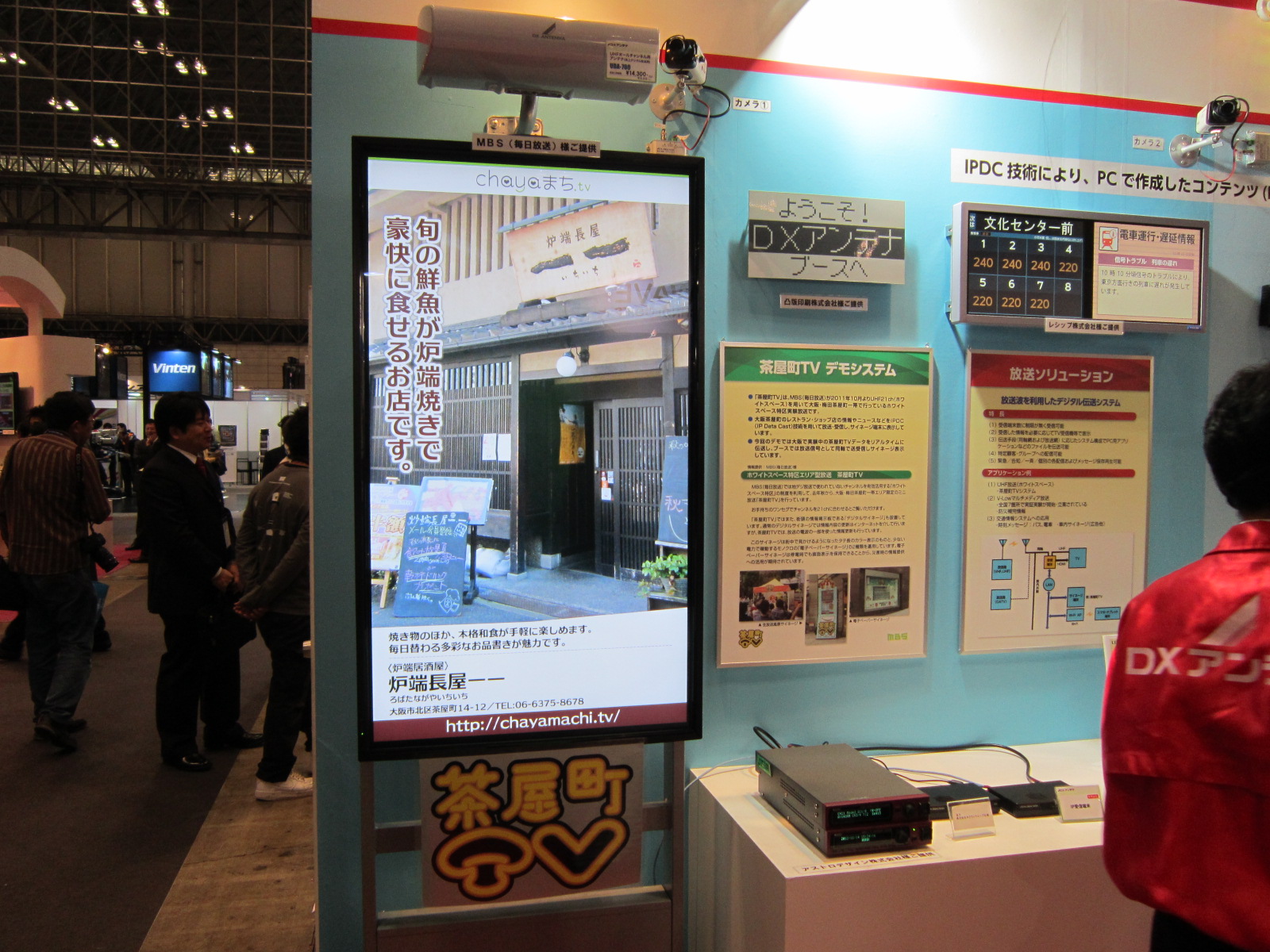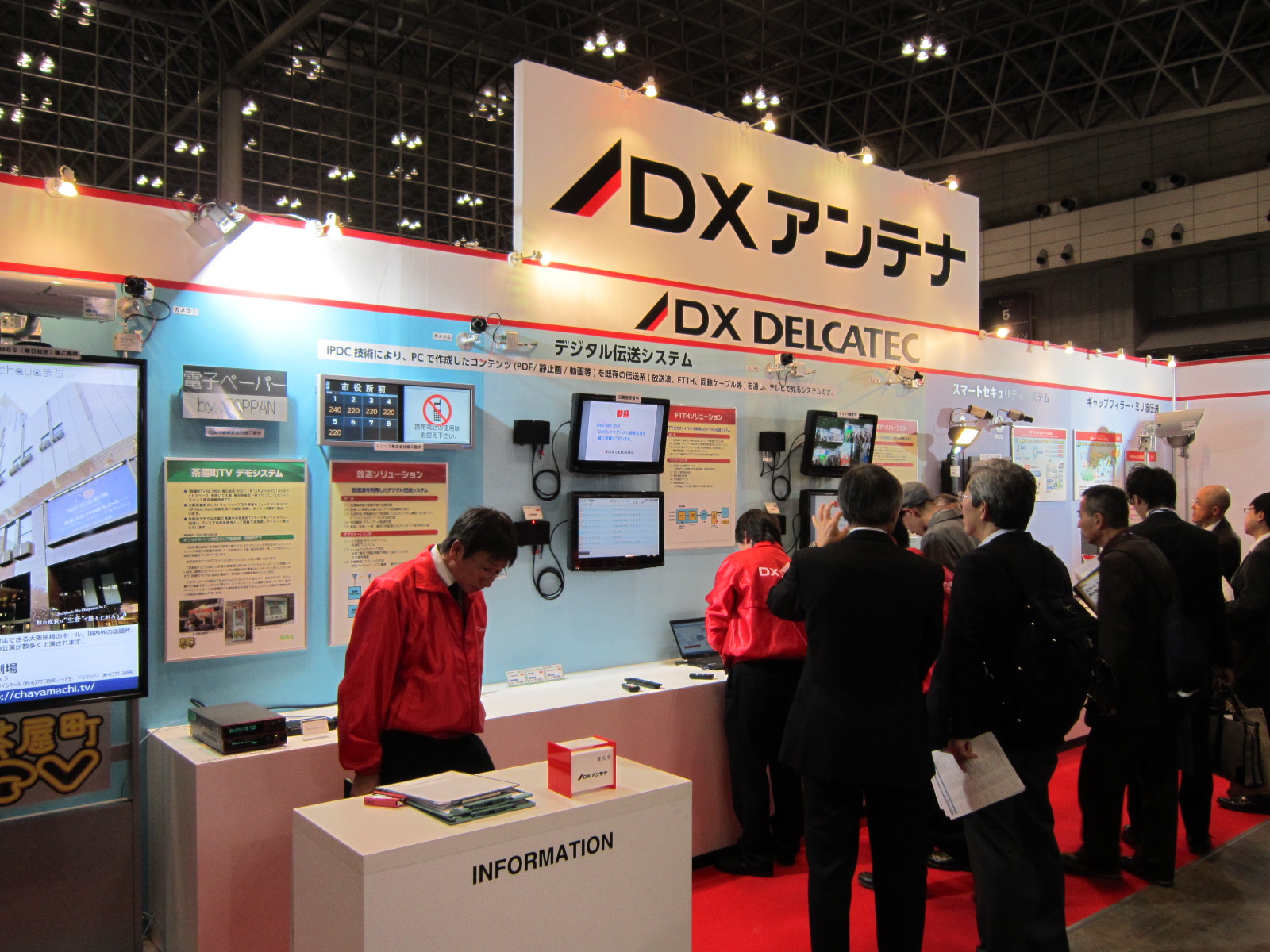Many next generation information transmission solutions, including the "Digital Transmission System" through IPDC and the industry's first "Milli-wave Transmission System"
2012.11.16 UP

DX ANTENNA (Video and Broadcast Equipment; #5508) exhibited a great number of next generation information transmission solutions, including the ""Digital Transmission System"" that utilizes IPDC (IP Data Casting) technology, the ""Milli-wave Transmission System"" that is the first in the industry to be able to transmit high definition broadcast signals wirelessly, the high resolution ""Full HD Watching System"" and the ""Gap Filler System"" that is equipped with a function that provides support during power outages.
■ IP data distribution becomes possible with a coaxial cable
The ""Digital Transmission System"" that uses IPDC technology was unveiled to the public for the first time at this event.
IPDC is a technology that is based on IP technology and which delivers IP data without the distinction of communications and broadcasting routes. This is a technology that allows a variety of digital data to be sent to coaxial cables through the medium of a RF modulator and also makes possible IP multicast distribution. The ""Digital Transmission System"" that was exhibited utilizes this IPDC technology to achieve various data transmission services.
In the booth, there were proposals for the application of ID data by coaxial cables. Even old buildings and housing complexes are equipped for television reception if there are coaxial cables, so new construction lines are unnecessary. The firm talked about the appeal of this system being that even in facilities where it is not possible for an IP network to be developed it is possible to construct an information transmissions network without a great deal of effort of cost.
Furthermore, there were also proposals for applications to broadcasting services. In the firm's booth, a demonstration was held on the pattern of an area broadcast from October 2011 given by Mainichi Broadcasting System (MBS) using this technology. Digital signage was installed on streets and this distributed area information and advertising targeting just that region. The firm is also exploring the possibilities of new broadcasting services because it is possible to deliver content targeting a particular area in real time without the need for large-scale broadcasting equipment.
■ The industry's first wireless digital broadcasting transmission system using milli-waves
The ""Milli-wave Transmission System"" is a wireless digital broadcasting transmission system that utilizes the frequency band of 60GHz. This frequency has made it possible for this system to be developed because its usage is permitted for multi-channel transmissions of high-quality video as a ""Specified Low Power Radio Station"" (unlicensed bandwidth of antenna power of 10mW or less) due to the revision of the Radio Law in 2000). It should be noted that radio waves of 30GHz to 300GHz (including this 60GHz) are called ""milli-waves"" because their wavelength ranges from 10mm to 1mm. This wireless digital broadcasting transmission system that uses milli-waves is the first such effort for this in the industry.
The system utilizes a bandwidth of up to 2.5GHz. It is possible to transmit multi-channel high-definition signals of BS 110 CS digital broadcasting and terrestrial digital broadcasting in this bandwidth with the high quality remaining intact. There are two systems: A reception interference measures system on the back of buildings and a shared reception system for housing complexes.
The reception interference measures system on the back of buildings amplifies signals received by an antenna with a transmitter amplifier and then sends these signals with a milli-wave transmitter. This is a mechanism that delivers signals to each home through the medium of a transmitter amplifier from a milli-wave receiver that has received these signals. It is possible to transmit wirelessly to approximately 60m between the milli-wave receiver and milli-wave transmitter.
On the other hand, the shared reception system for housing complexes provides reception to facilities that are old and which are not able to support satellite transmissions with equipment and cables. This is a mechanism that wirelessly transmits to lower floors signals received by an antenna installed on the roof which are then received by each home through antennas installed on verandas and other locations. The transmission distance is approximately 45m. In both cases, there is almost no need to route cables in the building, so it is possible to install in a short period of time without effort or cost.
■ Door to door distribution of images of remote locations by using existing shared antenna systems
The ""Full HD Watching System"" is one that allows people to watch the state of remote locations on digital terrestrial televisions by using existing shared antenna systems of housing complexes. It is possible to see videos of each home in a housing complex.
Specifically, a HD-SDI camera that is compatible with full high-definition is connected to a coaxial cable and is then linked to an existing antenna transmission line through an SDI relay, camera drive unit (HDMI output) and OFDM modulator. The feature of this system is that it is possible to transmit full high-definition video over long distances with a coaxial cable. The system allows transmissions up to 300m through the SDI relay. Existing antenna transmission lines are used, so there is also the benefit that it cuts down on the time required for construction.
This system has been designed for surveillance needs, such as education/public institutions, facilities and parking lots in housing complexes, shops and offices. It is said to be effective for safety and security measures because it is possible to watch over the state of remote locations at all times.
■ Eight hour transmissions of one specified wave with a built-in battery even in the event of a power outage
The feature of the ""Gap Filler System"" exhibited at this event is that it comes equipped with a support function for power outages, such as due to a disaster. There is a built-in battery which allows eight hours of continued transmissions of one specified wave (full seg/one seg). The one wave that is transmitted can be selected by replacing the unit.
""It is very important to continue broadcasts in order to provide information rapidly in the event of a disaster."" (Explainer) Therefore, a built-in battery has been placed in the gap filler so it is possible to continue transmitting broadcast eaves even if the power supply has been cut off. Long distance transmissions are possible due to optical transmissions between the reception point and transmission point. In addition, the digital terrestrial head amp and transmitter are the result of joint development with NHK Integrated Technology, including the system verification of NHK Engineering Services.









